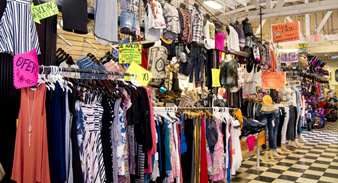Because 1979, El Faro Plaza has actually become Los Angeles's premiere indoor market, including over 250 suppliers, crafters, artists from all over the world, a real mix of Angelenos. This indoor swap meet, situated in Los Angeles, is a one-stop shopping center offering a wide range of stores, food vendors, and home entertainment for the entire household. And all at a great price! From foot massages to vehicle window tinting, from lingerie to quinceanera gowns, from unique birds to tvs, we have all of it under one giant roof.An indoor swap meet in the United States, particularly Southern California and Nevada, is a type of fete, a long-term, indoor shopping center open throughout normal retail hours, with repaired booths or stores for the vendors.Indoor swap meets house vendors that offer a wide variety of items and services, particularly clothes and electronics. For example, suppliers in the Fantastic Indoor Swap Meet in Las Vegas offer
clothes, furnishings, purses and toys, ... but there's a lot more: flowers and plants, pet supplies, leather items, sporting devices, perfume and cosmetics, travel luggage and electronics, to call just a couple of. There also are cubicles for services, including window tinting, palm reading, changes, etching and estate preparation. Most of items offered here are new, although antique street does feature some vintage and pre-owned goods. It is various in format to an outdoor swap meet, the equivalent of a flea market, normally open on a limited variety of days and often without repaired locations for its suppliers.

Indoor swap meets are present in numerous working-class communities throughout Southern California, with a concentration in Central Los Angeles. Indoor swap meets los angeles swap meet include the Anaheim Market, Fantastic Indoor Swap Meet in Las Vegas, and the High Desert Indoor Flea Market in Victorville. [5] Longstanding indoor swap meets that are now defunct include the Pico Rivera Indoor Flea Market [6] and San Ysidro Indoor Swap Meet.Swap fulfills in the U.S. long consisted of U.S.-born suppliers who sold primarily pre-owned items in outdoor areas. In the 1970s, Latino immigrants started offering cultural goods and budget friendly services at swap meets in Southern California and some swap meets started looking like the tianguis, open-air markets, of Mexico. At the same time, drive-in movie theaters were ending up being less popular, and their owners eagerly leased them out during the day to outdoor swap meets, which multiplied. Then, mainly Korean immigrants used their connections in the growing import/export trade with Asia to establish their own swap meet stalls and equip them with new, low-cost goods from Asia instead of previously owned goods. In the 1980s and 1990s as homes South Los Angeles and parts of Central L.A. became deserted and hence, inexpensive, Korean immigrants purchased them and turned them into indoor swap meets.